| Main | Site library | Forum | Guestbook |
THE HABITATS
NATURAL ENVIRONMENTS OF THE WORLD
EQUATORIAL FOREST
The steamy jungles of the equatorial belt
Equatorial forests are found along the equator in the Neotropical, the Ethiopian, the Oriental and a corner of the Australasian realms. Along the equator, a region of atmospheric low pressure is created, where the air heated by the tropical sun constantly rises. Consequently, winds blow continually into this region from both north and south, bringing heavy rainfall. The ensuing hot, wet conditions are ideal for plant growth, and forests and jungle flourish.
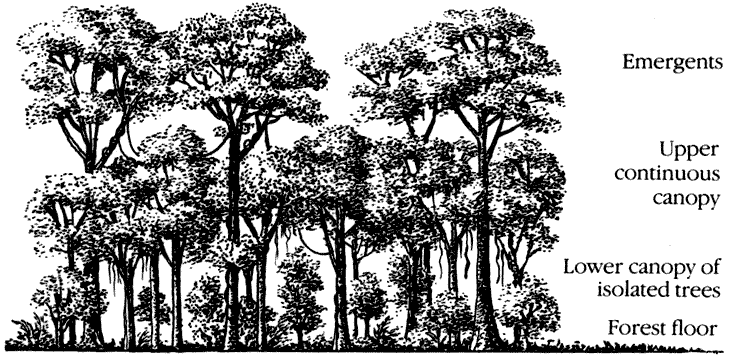
Tropical rainforest
Different layers of the tropical rainforest support different animals. The
emergents are home mainly to birds and pterosaurs. The canopy of interlocking
branches contains most of the tree-living animals. Fewer creatures live
in the gloom of the forest floor.
The hot, moist conditions are similar to those that existed during most
of the Mesozoic era, and many of the Mesozoic types of dinosaurs live successfully
here. There are, however, few large ground-living plant-eaters, since very
little undergrowth survives in the gloom of the forest floor, and the tree
trunks are often so close together that it is difficult for a big animal
to move. The big animals are restricted to forest clearings and river banks.
Most ground-dwelling plant-eaters are quite small and feed on roots, or seeds
and nuts.
Insects abound on the forest floor, and many insectivorous animals live here.
The ants and termites have evolved quite recently, and certain dinosaurs
have evolved an ant-eating adaptation to exploit them.
There is no record of tree-living dinosaurs from the Mesozoic era; however,
the tree-climbing habit has evolved among the new dinosaurs. These tree-dwellers
are small, active and warm-blooded. The warm-blooded condition is necessary
for an active tree-living existence that requires smooth muscular coordination.
Tree-living dinosaurs have grasping hands and feet to enable them to grip
branches, and they have evolved strong shoulder muscles, probably by re-evolving
obsolete collarbones. The evolutionary lines of the coelurosaurs and the
small ornithopods produced a number of tree-living dinosaurs.
Animals that jump between the branches of closely-spaced trees often evolve
into flying and gliding creatures. Several gliding dinosaurs evolved from
the tree-living coelurosaurs and these are found in the tropical forests
in various parts of the world. With so many different varieties of tree present
in the tropical forest, and so many different foods, such gliding animals
do not compete directly with the birds and pterosaurs that also live there.
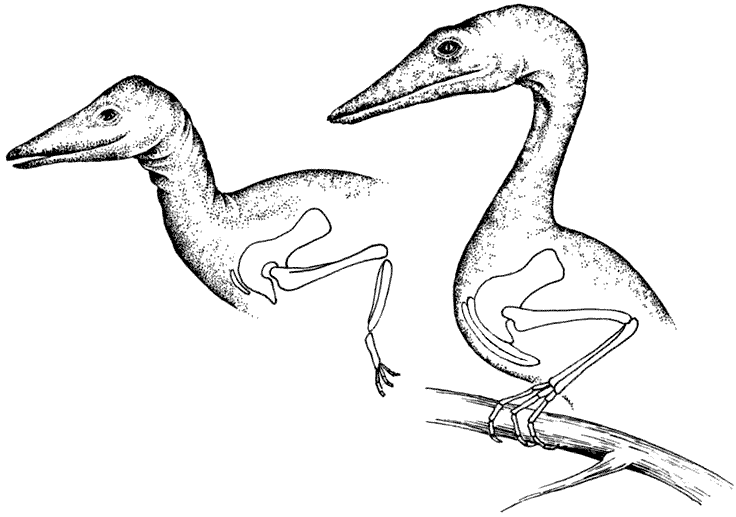
Collarbones
A conventional coelurosaur, above, has a very small collarbone, as the arms
do not need to be very strong. Its descendant, the tree-living arbrosaur
(page 33), right, has a strong collarbone to support its climbing muscles.
GRASSLANDS
The open plains
Grasslands are a relatively recent innovation to the face of the planet. There may have been areas of open country in the Mesozoic era but these would not have been clothed in grass. They are more likely to have been meadows of ferns and horsetails.
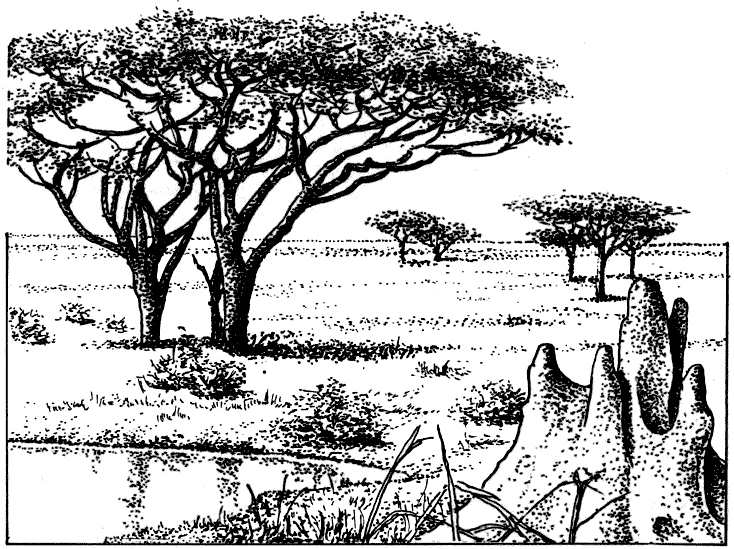
Tropical savanna
Grass is the important plant type on the open plains as it can survive long
periods of drought, and can regenerate quickly after it has been grazed
heavily. The only large plants are hardy thorn trees and scrubby bushes.
Tropical grasslands are now found in two parallel belts, north and south
of the equatorial rainforest belt. As the sun’s position in the sky moves
north and south with the passing of the seasons, it brings heavy tropical
rain in the summertime. During the winter the tropical rain is precipitated
in the opposite hemisphere and dry conditions prevail. Trees are not suited
to this seasonal weather but grasses thrive. Tropical grasslands are found
in the Ethiopian, the Neotropical, the Australasian and part of the Oriental
realms. Temperate grasslands cover large areas of the Nearctic and Palaearctic
realms and are found in dry areas far from the ocean.
Grasslands, both tropical and temperate, represent a totally novel environment
for the dinosaurs. Grass is a notoriously difficult substance to eat. It
has a high content of hard silica, and produces a great deal of wear on teeth.
It is also very indigestible, requiring sophisticated digestive systems.
The geography of grasslands also imposes restrictions on the animals that
live there. An animal roaming open plains can be seen from a long way off,
so it is conspicuous to any hunter. A grass-eater must, therefore, be able
to see any danger approaching from a long distance away, and be able to avoid
it by running.
The duck-billed ornithopods of the late Cretaceous period have developed
into grassland dwelling animals. Their batteries of teeth are ideal for coping
with tough grass because they are constantly being replaced as they wear
out. The development of a grassland animal’s body, with its long running
legs, does not represent a very great evolutionary step. Likewise, the long-necked
sauropods that have survived on the southern continents, are mainly grassland-dwelling
animals; they have not had to develop new adaptations because their sheer
bulk is enough of a deterrent against the plains-living predators.
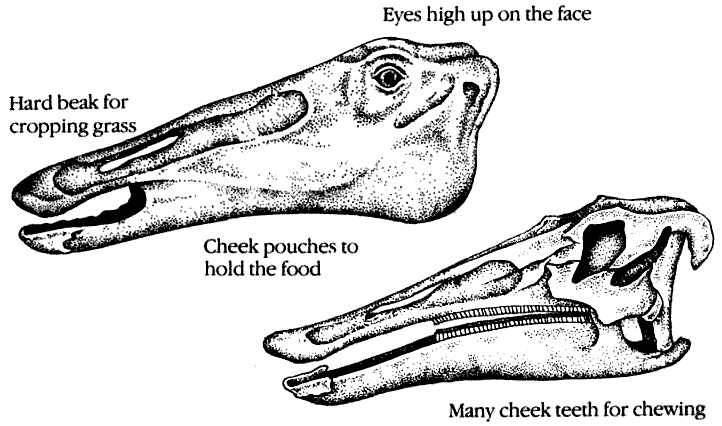
Grass-eating mechanism
The sprintosaur (page 56-7), a descendant of the duck-bills, has a long face
with deep cheek pouches. When it grazes, its eyes are well above grass level,
looking for danger. Its jaws have batteries of teeth that are constantly
replaced as they are worn down.
DESERT
Hot dry wasteland
Desert conditions are found in regions where the climates are too harsh
to support luxuriant vegetation, and hence do not provide a great deal
of food
to be exploited by animals.
There are several types of modern desert. The largest desert areas are
the tropical deserts that lie along the tropics of Cancer and Capricorn.
Here
the hot air that rises at the equator – the air that drops all its moisture
into the equatorial forests (page 20) – cools and descends. As a result,
very little rain falls in these areas and few plants struggle to grow
effectively in the constant dryness.
Continental deserts lie deep in the interiors of the largest landmasses,
particularly in the Palaearctic and Nearctic continents. Here the sea
is so distant that it has no effect on the local climate and the winds
are
always dry. Such deserts can be extremely hot in the summer, but icy
cold during
the winter months.
A rain shadow desert is found in the lee of a mountain range. The prevailing
wind drops all its moisture as rain on the windward side of the range,
and only dry winds pass beyond the mountains.
Since deserts are so inhospitable to animal life they often mark the
boundaries between zoogeographic realms, and indeed provide the barriers
that keep
the realms distinct.
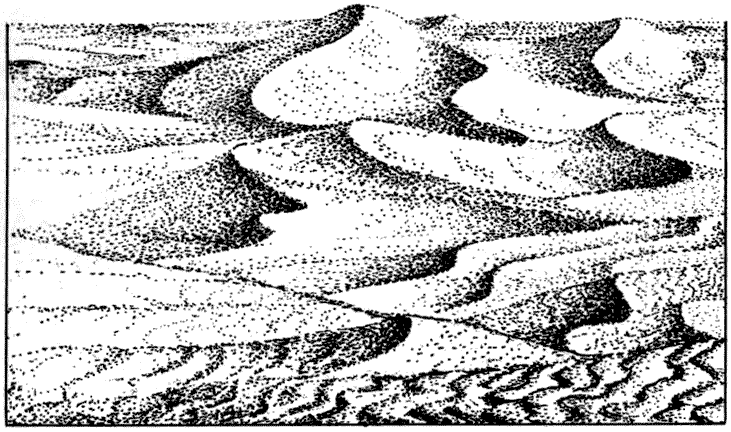
The barren waste
The desert surface can be quite varied. It may consist of flat wind-blasted
rock, loose gravel, hard clay or salt, or constantly shifting dunes of
sand as found in the tropical desert, above.

Water conservation
Desert animals need to conserve moisture. The taranter (page
52) uses the
armour that it inherited from its ankylosaur ancestor, top. The armour
has become a continuous waterproof covering above.
Desert conditions are so harsh that very few animals can survive in them.
Compared with the equatorial forest, life is very sparse indeed, both in
terms of numbers of species and abundance of individual creatures. Desert-living
requires particularly extreme adaptations. Animals of the desert must be
able to conserve their water to survive long periods in which there is little
to eat. Plant-eaters usually manage this by storing all the available moisture
present in the stems and seeds that they eat. Meat-eaters obtain water from
the moist flesh of their prey. Both types of animals have very efficient
kidneys that salvage every drop of moisture, and they rarely need to drink.
Desert animals must also be able to protect themselves from the fierce heat
of the day and the intense cold of the night. Small animals can do this by
sheltering in rocky crannies or by burrowing in the sand. Many animals have
evolved an impenetrable outer armour, not for defence, but to reduce the
evaporation of their body moisture.
Many of the reptile groups evolved in desert conditions and so most of the
desert vertebrates found today are reptiles. These include several dinosaurs,
most of which have developed the special adaptations needed for desert survival.
TEMPERATE WOODLANDS
The habitat with four seasons
The temperate woodlands lie in the mid-latitudes of the Earth, part way between the tropics and the poles. These are regions of unstable climatic conditions, caught between the warm air masses pushing polewards from the tropics and the cold air masses pushing outwards from the poles. The boundary between the air masses is not a constant one, moving to and fro each season, and twisting and curling about from day to day. In the lower latitudes of this belt the western edges of the continents tend to have warm, dry summers and mild, damp winters, while the eastern continental edges are continuously warm and humid. Towards the poles, the cold polar air has a more noticeable effect and damp conditions are evident in both summer and winter.
 |
|||
Spring In the spring the plants begin to grow. Most flowers and blossoms come out at this time and they are fertilized. |
Summer |
Autumn In the autumn growth stops. The fruits ripen, allowing the seed to be spread. Most trees shed their leaves for winter. |
Winter Winter is the dormant season. The plants, and the animals, conserve their energy for the growing period ahead. |
The greatest areas of temperate woodlands lie in the northern hemisphere.
The corresponding latitudes in the southern hemisphere are largely occupied
by ocean. Hence the Palaearctic and Nearctic realms contain most of the temperate
woodland areas, while only pockets are found in the Neotropical, Ethiopian
and Australasian realms.
Because of the seasonal nature of the climate, the temperate woodland tends
to consist of deciduous trees; those that grow well and flower in the spring,
mature in the summer, fruit and shed their seeds in the autumn, and drop
their leaves and lie dormant in winter. There is usually a thick undergrowth
of herbaceous plants in the temperate woodland, which dies back in wintertime.
The annual fall of dead leaves keeps the soil enriched.
Seasonal changes of climate did not take place during the Mesozoic era and
any dinosaur, or dinosaur descendant, living now has to contend with the
difference in temperature between summer and winter. This presents no real
problem for warm-blooded animals, and they can remain active through most
climatic conditions. The warm-blooded dinosaurs thrive in this habitat. During
periods of extreme conditions, the smaller dinosaurs hibernate, taking cover
to sleep away the worst of the cold. The tree-living vegetarian dinosaurs
are a good example; being small and active, they are able to hibernate in
hollow tree trunks after gathering a store of food during the summer and
autumn. Larger dinosaurs rely on their bulk to retain body heat and energy
during cooler periods. Although they tend to become sluggish in the winter,
they do not hibernate.
COLD FOREST
The northern girdle of conifers
The greatest uninterrupted expanse of forest in the world is found in the higher latitudes of the northern hemisphere. It forms a ring around the northern polar region. The heavy mass of cold air that lies over the north pole spreads outwards and southwards and governs the climate of the region. The climate tends to be very cold, with much of the water in the region locked up in ice for most of the year. The growing season here is very short, only 50 to 80 days, and the trees that grow must be able to withstand very poor conditions. The trees are mainly conifers, which are best suited to the cold climate. They have needle-shaped leaves that serve to reduce the amount of water lost through evaporation. Conifers do not drop their leaves in the winter, and so they are always available to provide the tree’s nourishment when conditions allow it. The conical shape of the trees is ideal for shedding the great weight of snow that is likely to fall during wintertime. The trees grow slowly, and usually more than one year is needed before a fertilized flower will produce a cone with seeds. With no leaves falling, there is no leaf litter, and the cold conditions inhibit the decay of any dead matter that lies on the ground. The topsoil is consequently very thin and there is little or no undergrowth that is able to survive. Similar growing conditions are found high up in mountainous areas, and coniferous forests are found here as well.
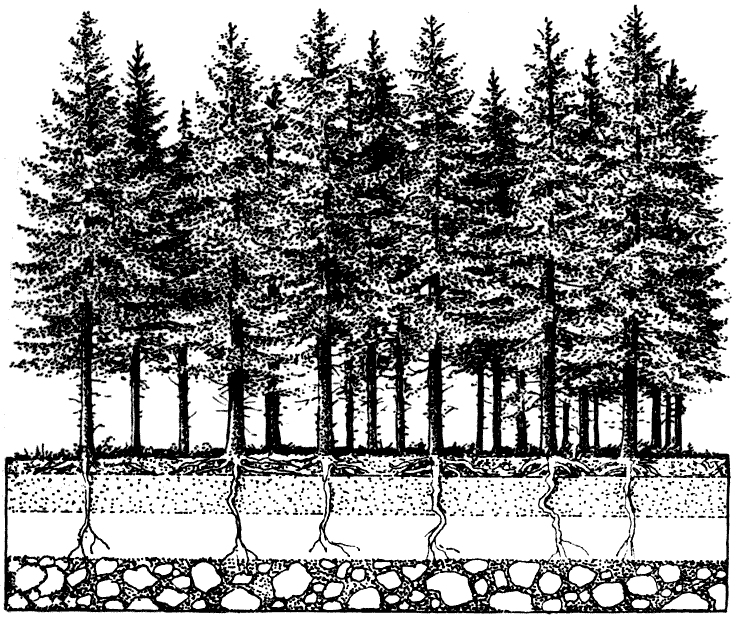
Coniferous forest
The thin soil of the coniferous forest floor is distinctly layered as the
cold conditions mean there are few burrowing animals to mix it up. The
trees often have a fungus coating their roots that helps them to absorb
nutrients.

Migration
Migrating animals, such as the coneater (page 48), travel from the coniferous
forest as soon as the snows begin, and spend the cold months by rivers
in the temperate forest zone.
The great belt of northern coniferous forest lies in the Nearctic and Palaearctic
realms, and mountain coniferous forests are found in small areas in all the
other realms. There is no continuous coniferous forest belt in the southern
hemisphere because ocean lies at the relevant latitudes.
Few animals exist in the cold forests as there is so little food available.
Animals that do survive are very specialized feeders and do not compete with
one another for food. Small animals, particularly mammals, are active during
the winter, digging tunnels through the snow and feeding on seeds and insect
larvae. The larger animals tend to migrate southwards to places where the
climate is less harsh.
TUNDRA
The cold desert
Around the fringes of the northern ice cap, in the Palaearctic and Nearctic realms, there is a region of cold desert known as the tundra. During the long Arctic winter this region is as cold and bleak as the ice cap itself, but during the short summer the temperature may rise above freezing point, possibly attaining an average of 10 degrees Celsius (50°F). The covering of snow and ice will melt, but the water cannot drain away because of a permanent layer of frozen soil (the permafrost) below. The landscape becomes a waterlogged marshy waste of lakes and bogs.

A bleak landscape
The ground surface of the tundra thaws out in the summer, but the water cannot
drain away because the ground is still frozen solid at depth. The summer
tundra landscape is one of soggy marshes and temporary lakes with sparse
vegetation.
The plant life of the tundra typically consists of low bushy herbs, mosses
and lichens. At the southern fringes, straggly trees like birch and rowan
grow as the tundra grades into the coniferous forest belt.
The growing season is very short, and many of the plants reproduce asexually
rather than through the long process of flowering, fertilization and germination.
The sudden growth of the tundra vegetation in the summer is accompanied by
a bloom of insects that suddenly appear to take advantage of the brief period
of warmth and sunlight. This short-lived flourishing of plant and insect
life means that food is only available in the tundra for a limited period
each year. Animal life in these regions tends to consist of migratory creatures.
Birds flock to the tundra in the summer to feed on the abundant insects,
but fly south for the rest of the year. Larger animals are also migrants,
and wander the tundra wastes grazing from the mosses and lichens during the
summer, but in the winter they are found in the south, sheltering among the
great coniferous forests.
The areas of tundra that exist now are quite recent, from a geological point
of view. They appeared when the ice caps appeared, reaching their greatest
extent during the Ice Age. Evolution has not yet progressed sufficiently
to produce a suite of animals that are specifically adapted to the strenuous
conditions, There are hardly any modern dinosaurs here, despite the warm-blooded
systems that they may have evolved. The environment is just too unpleasant.
The large animals have evolved from the birds that have adopted a ground-dwelling
existence because of the lack of predators; and these animals are only present
during the summer. Throughout the year they migrate in herds north and south
between wintering in the coniferous forests and spending the summer on the
waterlogged tundra.
 |
|
|
 |
WATER
The fluid surface of the earth
More than two-thirds of the planet is covered with water. The greatest
depths are found in the oceanic trenches that are offshore along the
mountainous
edges of the continents. Most of the ocean floor consists of the abyssal
plain, at depths of about 4,000 metres (over 13,000 ft). These regions
contain living creatures but when compared with the shallower, more
productive, regions
of the ocean, they appear quite barren.
The continents are not entirely dry land, but are, to some extent, flooded
at the edges. The submerged margins constitute what is known as the continental
shelf, and this is usually shallower than about 150 metres (500 ft).
Sea water into which sunlight penetrates, and that is usually to depths
of about 100 metres (300 ft), can support plant life. Sea-living plants
are
mostly algae, and can float near the surface or grow on the bottom in
shallow waters. Small animals feed on these plants, and larger animals
feed on
the smaller. Dying creatures sinking into the depths feed other animals
that
live in the darkness.
Over a period of time, the greatest evolutionary’ changes tend to take
place among the larger creatures. During the Devonian period certain
fish left
the water and so began the dynasty of land vertebrates. Not long after,
several of the newly evolved land animals returned to the sea and re-adopted
the
aquatic way of life. The sea reptiles became large and spectacular during
the Mesozoic period. None of these great reptiles were dinosaurs because
the sea reptiles had become thoroughly established before the dinosaurs
had evolved sufficiently to pursue that way of life. In modern times
this pattern
has persisted. There are no modern sea-living dinosaurs, but the traditional
sea reptiles have continued to evolve and populate the sea.
To live in water it is necessary to have a streamlined shape. Water is
a more difficult medium to move through than air. The classic teardrop
shape
found in fish is ideal, and an animal that chases and eats fish tends
to evolve a similarly efficient shape. Paddles and fins are more use
than
legs and feet and these tend to be evolved, as do breathing systems that
enable
the animal to spend long periods beneath the surface. Many types of reptile
have evolved these features to take advantage of the way of life offered
by the sea.
 |
The ocean layers
Only the thin euphotic zone of the sea has abundant plant life. The pelagic
zone is populated by hunters. Detritus feeders live deep in the abyssal
zone, feeding on dead material from above.

Swimming adaptation
The plunger (page 103) is a pterosaur that has changed from a flying to a
swimming way of life. The body has become streamlined and fish-shaped.
The wings have changed into steering paddles and a strong swimming paddle
has developed on the hind legs and tail. It limits fish in the euphotic
zone of the ocean.
AIR
The Earth’s envelope of gas
Perhaps the most unusual habitat to be occupied by a living creature is
the air. The colonization of habitats depends upon the availability of
a food
supply in that habitat. However, animals did not originally take to the
air for this reason. Flight was a means of transportation from one area
to another,
whether from cliff-top to sea, or from tree branch to tree branch. Flight
must have existed in the animal kingdom since the animals first left
the water and came out on to land. Insects were among the earliest of the
land
animals and flight was developed early in their history. The earliest
vertebrates to fly were various kinds of gliding lizard-like creatures in
Permian and
Triassic times. They flew by means of gliding membranes supported by
extended ribs reaching out along each side of the body. There was no muscular
action
involved and the flight was no more than a glide that would not have
been particularly well controlled.
The true masters of the skies became the pterosaurs. They were equipped
with wings that were supported by their forelimbs and controlled by powerful
muscles.
They were fliers in the true sense and could flap their wings and control
their actions very carefully. Many different types of pterosaur evolved,
ranging from tiny creatures with a wingspan of a few centimetres that
fed on insects, to huge creatures with wingspans of 12 metres (40 ft),
that
must have fed on carrion. The pterosaur’s body became perfectly adapted
for flight.
The weight of a flying creature must be kept to a minimum, and the bones
were hollow, dispensing with unwanted mass. The body must be rigid, to
cope with the fantastic stresses put upon it by the action of flight.
Hence, the
back vertebrae were fused together as a solid rod. Quick reflexes and
reactions are required to coordinate flying actions and keep the flight
under control,
and so pterosaurs developed a warm-blooded metabolism. As the Mesozoic
period progressed, the pterosaurs were as successful in the skies as
the dinosaurs
were on the ground, and they have remained the masters of the skies today.
Halfway through the Mesozoic period, the birds evolved from coelurosaur
stock. In many respects they parallelled the pterosaurs as they had wings,
hollow
bones, rigid bodies and a warm-blooded metabolism. They joined the pterosaurs
in the air and now these two major groups share the environment of the
skies between them.
More recently several dinosaurs have adapted to the air. They are most
commonly found in the tropical forests where various gliding structures
have evolved
to help the tree-living dinosaurs move from one tree to another. These
simple mechanisms are very primitive and quite similar to the gliding
structures evolved by the early reptiles in Permian and Triassic times.
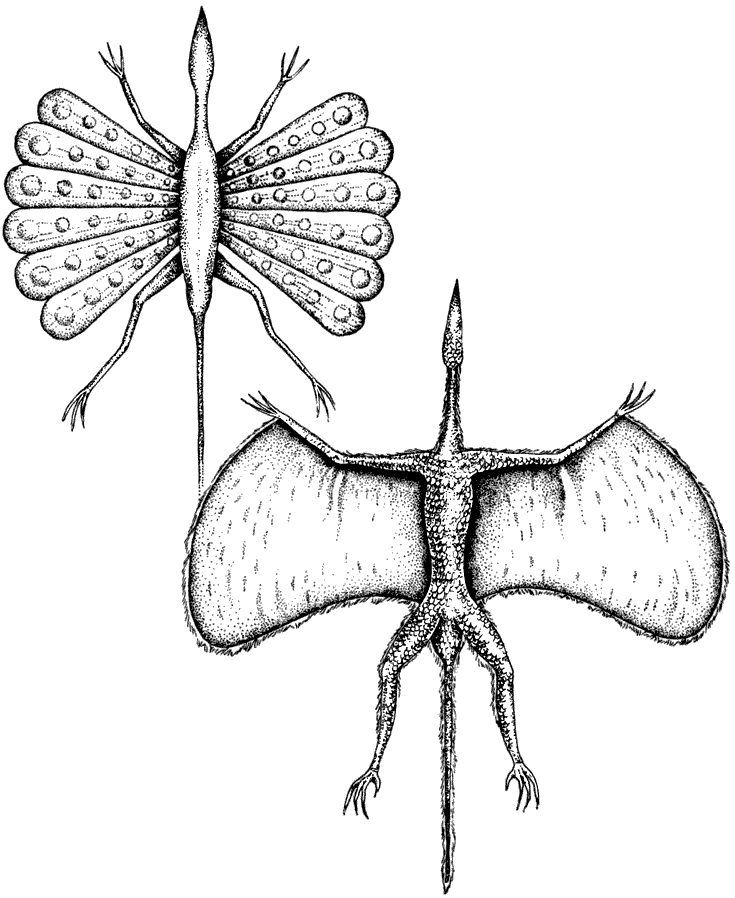
Flight adaptations
The gliding dinosaurs have adapted to flight in different ways. The scaly
glider (page 71) of the Neotropical realm top,
flies by means of paddle-shaped scales. The flurrit (page
85) of the Oriental realm above, has flaps of
skin, or patagia, between its arms and body.
CONTENTS
FOREWORD
THE GREAT EXTINCTION 6
WHAT IS A DINOSAUR? 10
THE NEW TREE OF LIFE 12
PALAEOGEOGRAPHY 16
ZOOGEOGRAPHY 18
THE HABITATS 20
THE NEW DINOSAURS 29
THE ETHIOPIAN REALM 30
THE PALAEARCTIC REALM 42
THE NEARCTIC REALM 54
THE NEOTROPICAL REALM 66
THE ORIENTAL REALM 78
THE AUSTRALASIAN REALM 88
THE OCEANS 100
CONCLUSION 108
AFTERWORD 109
GLOSSARY 113
FURTHER READING 115
INDEX 116
ACKNOWLEDGEMENTS 120